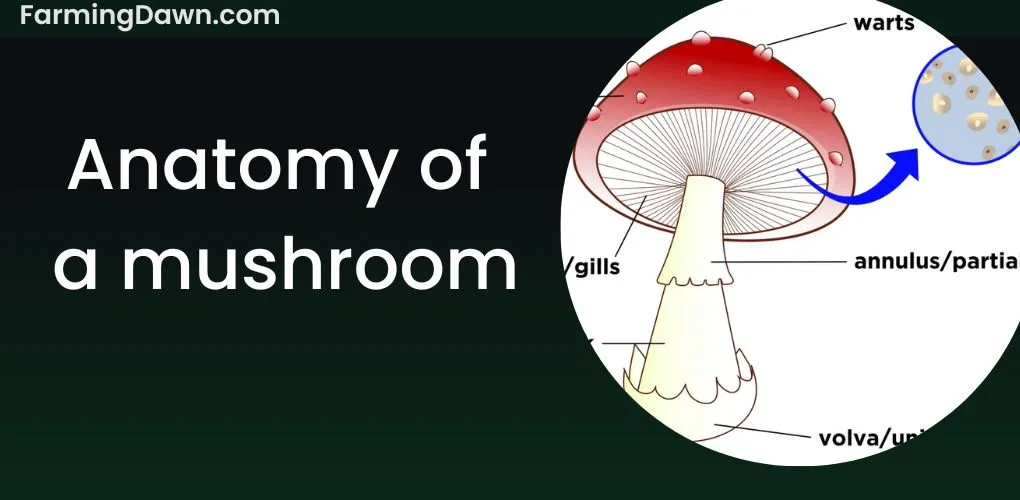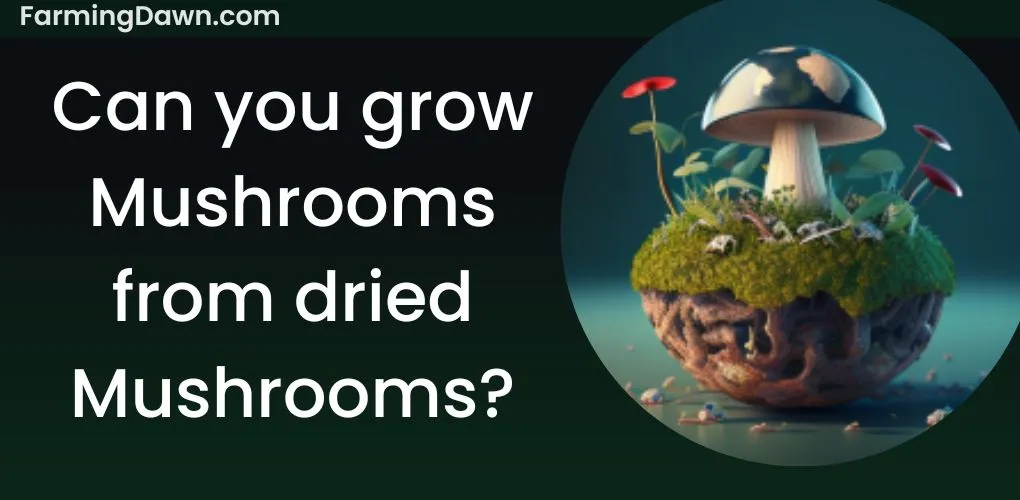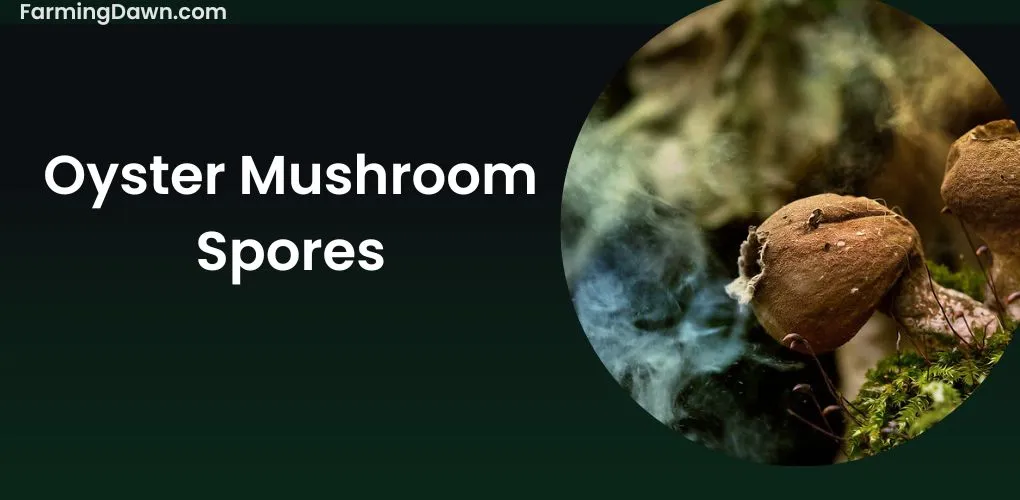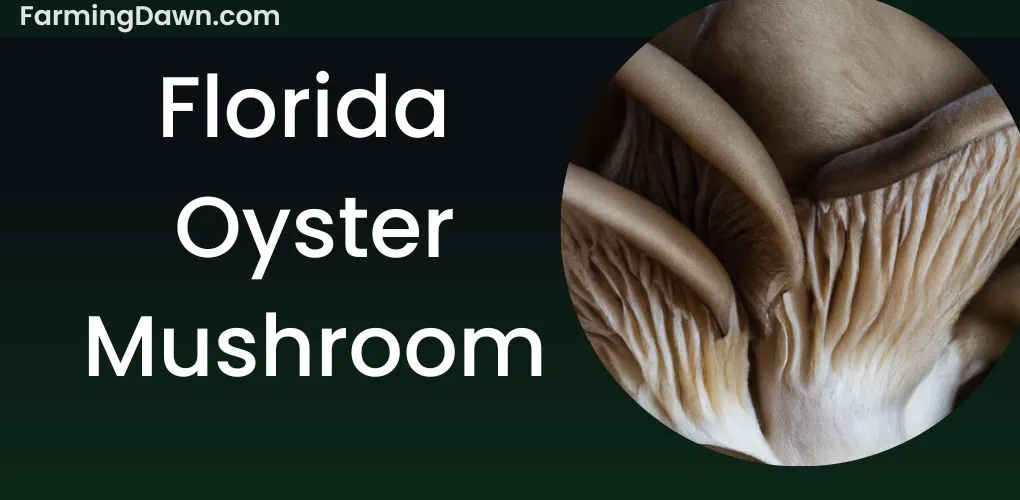Understanding the anatomy of a mushroom is the key to unlocking its full potential as a flavorful and nutritious ingredient. They’re a fascinating group of organisms with a rich history and intricate structure. From the cap to the mycelium, each part of a mushroom plays a vital role in its growth and survival. But how much do you know about the different parts of a mushroom?
This article will give a depth exploration of the anatomy of mushrooms, from their gills to their stems and everything in between.
Anatomy of a Mushroom: Overview Of Fungi
People have valued mushrooms for their flavor and nutritional content. They are an intriguing species of fungus. Though their anatomy can seem simple on the outside, it is very complex. At the base of the mushroom is the mycelium, a web-like network of tiny, branching threads that takes nutrients from the soil.
Above the mycelium is the stalk, which holds up the cap. The cap is then placed over the veil, a thin covering that shields the gills beneath the cap. The mushroom’s generative cells, called the spores, are formed by these gills.
Note: If you are wondering about these complex parts. I have a whole section for that in the next step.
Parts of a mushroom and their functions
When we think about mushrooms, we frequently picture the delectable trimmings that go into making dishes like garlic mushrooms or mushroom linguine. But did you know that the parts of a mushroom fruiting body, even the ones involved in reproduction, have a crucial function?
Because of the spores that the mushroom generates, the entire network of mushrooms can develop and spread. Nevertheless, not all mushrooms are made equally. Each one has a distinctive anatomy of its own. Some have pores or teeth, while some have gills.
Some wear rings, while others wear volvas. It’s a true work of nature! These are the parts of a mushroom fruiting body. I will now go over each one separately.
Cap of mushroom
I have many people asking this question. What is the top of a mushroom called? The answer is “Cap.” The cap is among the distinctive components of mushroom anatomy. This umbrella-shaped structure guards the gills, which are completely in charge of spore production and release of spores required for the mushroom to reproduce.
There are various varieties of caps, each with unique characteristics. Some are ridged and uneven, while others are smooth and rounded. Some are drab and rustic, while some are vividly colorful. The cap’s form and color can offer crucial hints for determining the type of mushroom.
When identifying mushrooms, the cap is frequently one of the key characteristics. Mushroom hunters and scientists can limit the potential species and decide whether a specific mushroom is edible or dangerous by looking at the form, color, texture, and other characteristics of the cap. I hope this clears your query. What is the top of a mushroom called?

Gills of mushroom
What is the underside of a mushroom called? The underside of mushrooms is called the gills. The creation and spread of spores, which can only be accomplished with gills, are important in reproducing mushrooms. They can accomplish this and raise their chances of being transported away and settling on a surface ideal for growth by dispersing the spores into the air.
Mushrooms have various gill types, each with its special characteristics. Adnate gills, which are attached to the mushroom stem, and free gills, which are completely unattached, are examples of common types.
Gills can be recognized by their color, form, spacing, and other characteristics. For instance, certain mushrooms may have closely clustered gills, while others may have more widely dispersed gills.
Gills present on the underside of a mushroom could be a significant indicator. Size, form, and color help you narrow down the possible species and identify an animal more accurately. This was the answer to your question. What is the underside of a mushroom called?

Teeth of mushroom
Mushroom teeth are one of the characteristics that set some fungal species apart from others. These features are seen on the undersides of mushroom caps and resemble tiny spikes or hairs.
In terms of function, teeth expand the mushroom’s spore-bearing surface, enabling more effective spore dispersion in the anatomy of mushrooms. They assist in preventing wind and rain from harming or destroying the spores.
Teeth come in a wide range of varieties, each with unique characteristics. The branching tooth, which resembles a tree with many branches, is one popular variety. This tooth has heavily branching spines that give it a feathery appearance.
The smooth tooth is another variety, with straight spines without any branches. In addition to being longer and thinner than those on branched teeth, this form of tooth also has longer spines.
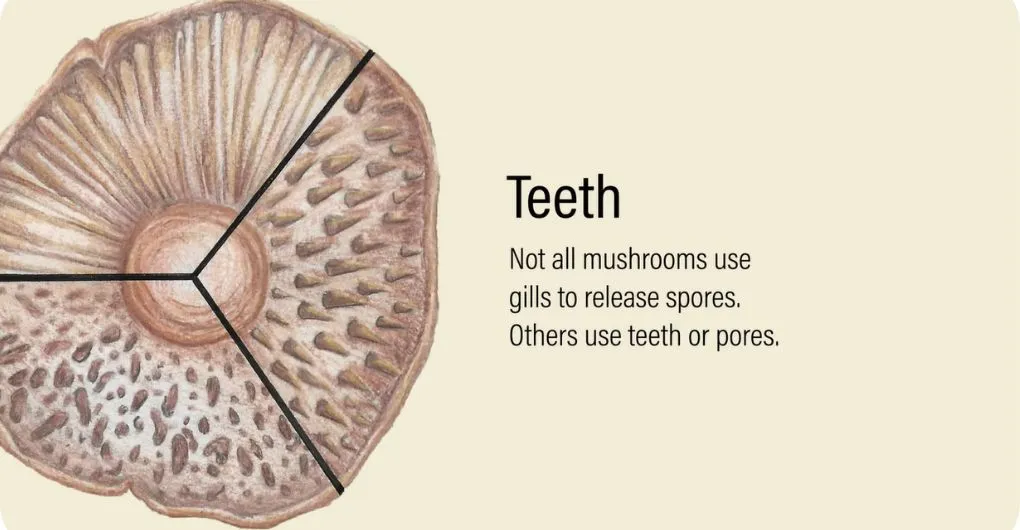
Stem of mushroom
The stem acts as the support structure for the cap or pileus of the mushroom by providing stability and balance to the overall fruiting body.
There are different types of stems found in mushrooms, and they can be used to distinguish between different species. For instance, while some stems are thicker and may have scales or rings, others are softer and cylindrical.
Several species of mushrooms can be distinguished by the shape and texture of the stem.
One distinguishing feature of the stem is the presence of a veil, a thin membrane that covers the gills or pores on the underside of the cap. Some mushrooms also have an annulus or ring on the stem, which is the veil’s broken remnant.
The stem is essential for the mushroom’s ability to reproduce and support the cap. Spores are produced by the pores or gills on the inside of the cap, which are then discharged into the atmosphere. The spores can spread far because the stem supports the cap while it is up.

Ring or Annulus of mushroom
The ring is a thin, often fragile band of tissue that circles the stem of a mushroom. It is formed as the mushroom cap expands and pushes up against the stem, leaving behind a remnant of tissue.
There are many different kinds of rings that can be found on mushrooms, each with its distinguishing features. Some rings are pendulous, hanging loosely from the stem, while others are firmly attached and difficult to remove. Some rings are located near the top of the stem, while others are closer to the base.
These variations in ring placement and appearance can provide important clues for identifying different mushroom species.
The importance of the ring in mushroom identification must be considered. Along with other features like gills and spore color, the ring can help distinguish between similar-looking species. For example, the presence or absence of a ring can be used to differentiate between poisonous and edible mushrooms.

Spores of mushroom
The spores of mushroom are the building blocks of life in the mushroom kingdom. These small, microscopic spores are essential to the reproduction of mushrooms, much like a plant’s seeds are. While some mushrooms prefer to rely on water or animals for their dissemination, some have the almost magical capacity to transmit these seeds via the air. To assure the continuing dissemination of their spores, some have even gone so far as to co-evolve with insects.
You will not be capable of seeing these spores with naked eyes as they are so tiny. Unless you happen to encounter a massive clump of spores that would appear to be nothing more than dust or powder, they are so small that only a microscope can reveal their presence. These minuscule wonders contain all the genetic material needed to create a new mushroom. Their distinct hue can be used to identify several species.
A mushroom will release its spores into the atmosphere at the end of its reproductive cycle, enabling them to disperse across its habitat. The spores will germinate and establish roots in a warm, moist, and shady place once they locate an appropriate location. Even more extreme conditions, like the icy tundra of Antarctica, Chornobyl’s radioactive wastelands, and even the bottom of the ocean, haven’t stopped some mushrooms from adopting.
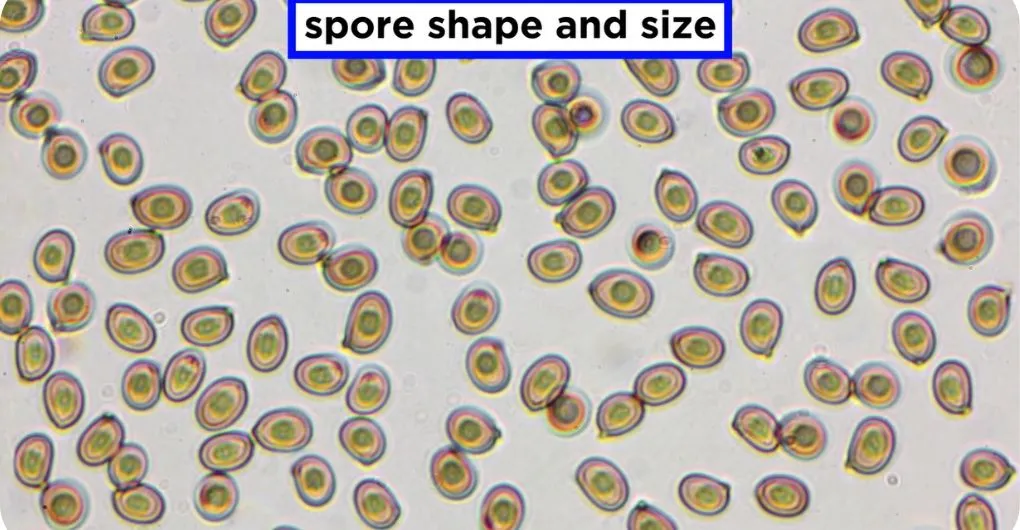
Volva of a mushroom
The volva is a distinctive feature that plays a crucial role in the anatomy of a mushroom for the identification of different species. The developing fruiting body is shielded by the volva, a cup-like formation at the mushroom’s base. Its purpose is to contain and safeguard the mycelium, the mushroom’s vegetative portion that takes nutrients from the earth for growth.
Volvas come in a wide variety of species of mushrooms. The most common type is the global veil volva, which covers the entire mushroom throughout its early growth stage. As the mushroom ages, the global veil volva rips open, leaving fragments at the base of the stem. The Amanita genus of mushrooms frequently exhibits this characteristic.
The partial veil volva is a different variety of volva that only partially envelops the mushroom cap. Several types of mushrooms, particularly those in the genus Cortinarius, contain this particular volva. When the partial veil volva breaks open, the annulus, a unique ring around the stem, is frequently left behind.
The color and texture of the volva are two of its defining characteristics. The volva can range in thickness from tiny and fragile to thick and membrane in some mushroom species. The volva’s hues range from white to brown or even red.
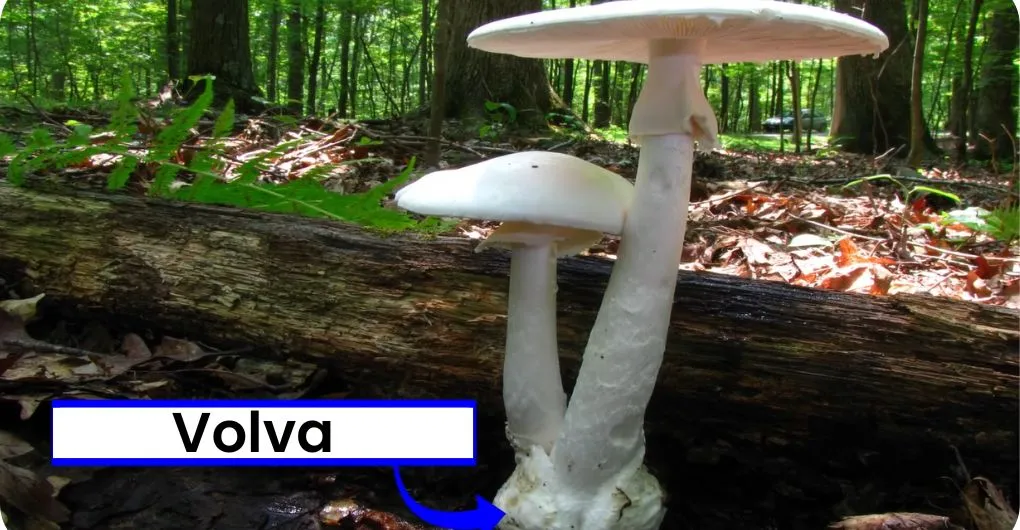
Mycelium of a mushroom
The vegetative portion of a fungus is called mycelium, which is made up of a network of branching, threadlike hyphae. It is an essential component in the anatomy of a mushroom. Its main job is to break down organic matter and absorb nutrients from the surrounding environment to support the growth and reproduction of the mushroom-fruiting body.
One distinguishing feature of mycelium is its ability to communicate with other organisms in the soil through a network of underground pathways. Mycelium can interact with plants in a mutually beneficial way, exchanging nutrients and water for carbon through the “Wood Wide Web” of communication.
The ability of mycelium to create substances having therapeutic characteristics, such as polysaccharides and beta-glucans, is another distinctive quality of this organism. These substances have been demonstrated to stimulate the immune system, and they may even be useful in the treatment of cancer.

What Parts of The Mushroom Can Be Consumed?
Mushrooms are a fantastic culinary component that can be used in many different forms of cooking. Not all components of the mushroom are edible; some may even be harmful.
The portion of the mushroom that is often consumed is the fruiting body or visible portion of the mushroom which is grown above the ground. The mushroom’s cap and stem are edible and can be prepared in various ways. Almost all of the mushroom parts are edible, but people like to consume the cap and stem much more than any other part.
It is essential to keep in mind that the gills, which are found on the underside of the mushroom cap, should be removed before cooking. This is because they could be challenging to chew and digest. In rare circumstances, dangerous substances might also be found.
Mushroom anatomy Diagram

Do Mushrooms have roots?
First, let’s tackle the question of whether mushrooms have roots. The answer is yes and no, depending on how you define “roots.” While mushrooms lack the conventional roots that trees have, they do contain a structure resembling those roots called mycelium.
A network of minuscule, threadlike structures called mycelium spreads across the substrate or soil to aid the mushroom in absorbing nutrients.
The Difference Between Roots and Mycelium
But how are roots different from mycelium? Roots are part of the root system of a plant or tree, which is made up of multiple individual roots. Mycelium, on the other hand, is a single structure that can surround a considerable area.
Roots take in water and nutrients, whereas mycelium does this and more. It also breaks down organic waste in the soil and forms a symbiotic relationship with plants.
Is There Evidence of Roots in Mushrooms?
Some claim that mushrooms do have roots, though. They emphasize the fact that mycelium is a structure that secures the mushroom in place and that it serves many of the same purposes as roots. Some claim it is incorrect to refer to mycelium as “roots” because it has a fundamentally different structure and serves different purposes.
I believe that the argument is largely semantic. The reality remains that mushrooms have a sophisticated system of food absorption and symbiotic interactions with other species, whether you call it their roots or mycelium. It’s amazing to consider how these minuscule, threadlike structures can have such a significant influence on an ecosystem’s health.
What are mushroom roots called?
Mushrooms lack roots, unlike the majority of plants. Rather, they have a mycelium, which consists of a complicated underground system of threadlike formations. The growth and spread of the fungus depend on this mycelium, also referred to as the “vegetative component” of the mushroom.
There are two names for the parts of the mushroom roots. The many strands that make up the mycelium are called “hyphae.” Whereas, the symbiotic relationship between the mycelium and the roots of other plants is referred to as “Mycorrhiza.”
Are mushrooms a sign of good soil?
In addition to being delicious and healthy, mushrooms are essential for enhancing soil quality. Growing mushrooms in the soil cause decomposing in organic material to liberate nutrients into the soil.
Decomposition is the term for this action, which is essential for good soil. Organic material, such as dead plants, leaves, and animal dung, decomposes, releasing the nutrients for use by subsequent plants.
Mushrooms also produce a substance called glomalin that aids in tying soil particles together. Stable soil aggregates are produced by this binding process, which enhances soil structure and water retention. Plants may access nutrients and water more effectively and grow and yield better with enhanced soil structure and water retention.
The Benefits of Mushrooms for Agriculture
Many advantages of mushrooms for agriculture include better soil health, enhanced plant development, and higher crop output. Mushrooms can be used in agriculture to lessen the need for artificial pesticides and fertilizers, which are bad for the environment and people’s health.
There are numerous methods for growing mushrooms, including in beds, compost, and logs. They can also be used as a cover crop to add more organic matter to the soil and prevent erosion. Also, it has been demonstrated that some mushroom species possess inherently fungicidal qualities, which can aid in the management of plant diseases.
The Role of Mycelium in Soil Regeneration
The vegetative portion of a fungus that develops underground, called mycelium, is essential for soil regeneration. Mycelium may cover massive expanses of soil with its vast network of threadlike filaments. This network aids in the decomposition of organic material and the release of nutrients into the soil.
Moreover, mycelium creates enzymes that can degrade hazardous compounds in the soil, lessening their negative effects on plants.
Moreover, mycelium and plant roots can develop symbiotic interactions. Mycorrhizae, a plant connection, improve nutrient uptake and shield plants from pests and disease. In exchange, the plants give the mycelium the carbohydrates it requires to develop and flourish.
Anatomy of a mushroom: Conclusion
That concludes our exploration of the anatomy of a mushroom. From the cap to the stem and the gills to the spores, there is so much to explore and learn. Understanding the many components of a mushroom allows you to not only enjoy its beauty but also to identify and cook them in an informed manner. Ask me in the comments if you have any further queries.
Each fungus has different anatomy and characteristics. Read my other articles to learn more:

